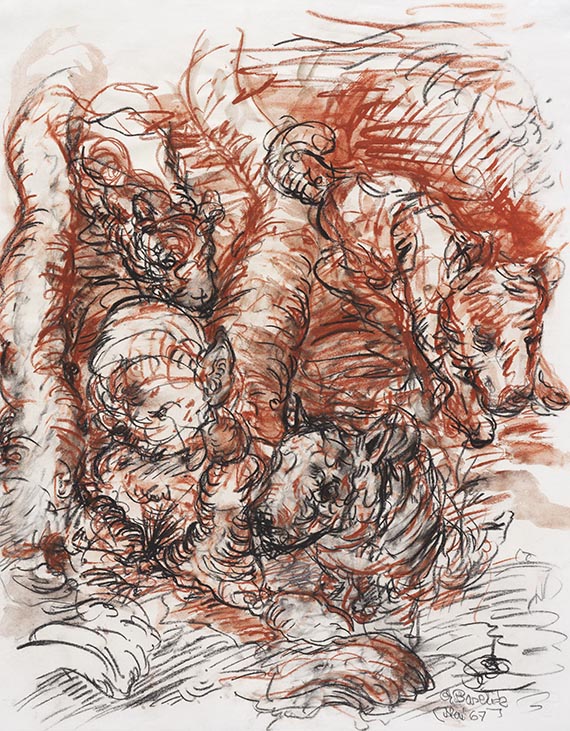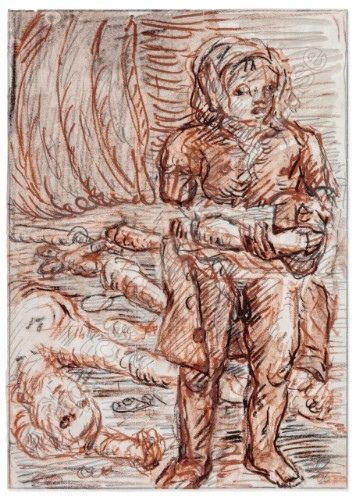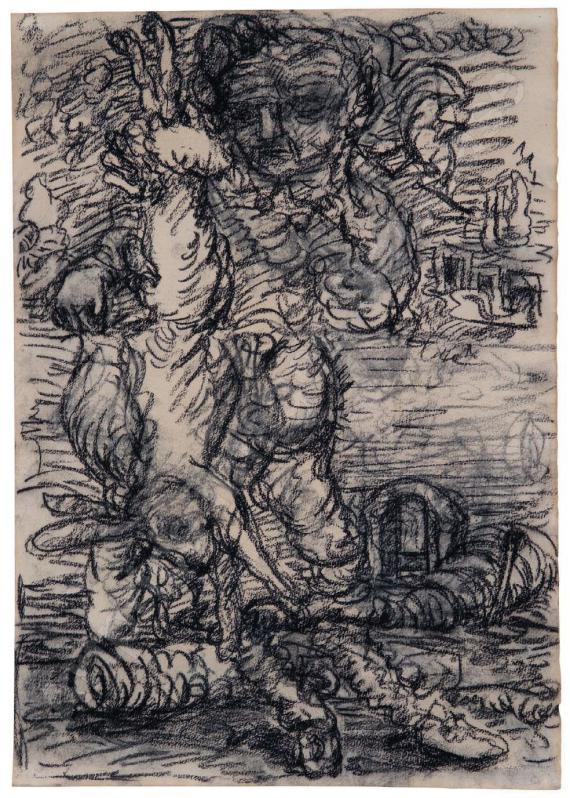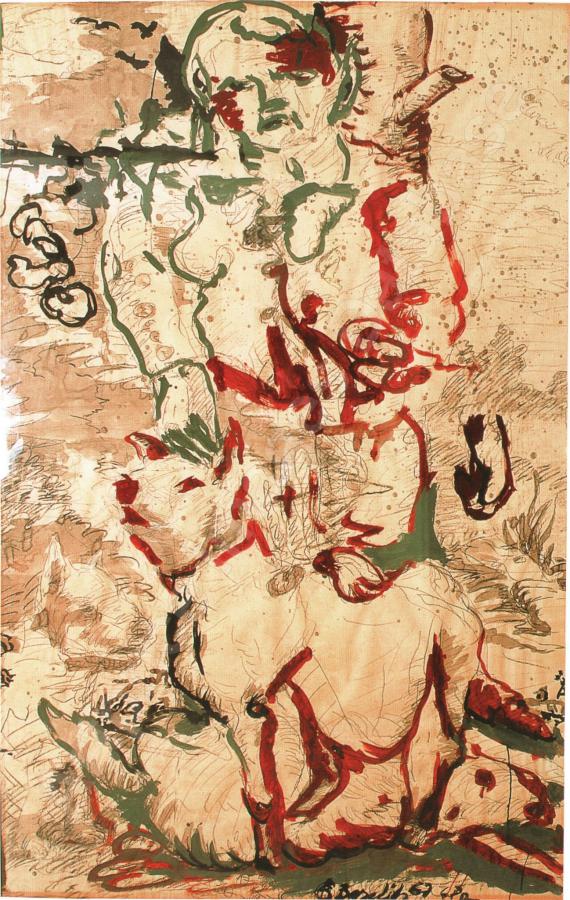Sale: 550 / Evening Sale, June 07. 2024 in Munich  Lot 124000058
Lot 124000058
 Lot 124000058
Lot 124000058
124000058
Georg Baselitz
Tiere, 1967.
Black and brown Chalks, with wash
Estimate:
€ 120,000 - 150,000
$ 128,400 - 160,500
Information on buyer's premium, taxation and resale right compensation will be available four weeks before the auction.
Tiere. 1967.
Black and brown Chalks, with wash.
Lower right signed and dated "Mai 67". Signed, dated and titled on the reverse. On off-white Hahnemühle laid paper (with the watermark). 62.5 x 48.5 cm (24.6 x 19 in), the full sheet.
• From his best creative period: Baselitz relentlessly confronts post-war German society in the 1960s with its historical guilt and the trauma of the war.
• Outstanding, early testimony to Baselitz's masterful play with art-historical tradition, the power of provocation and association.
• Baselitz decontextualizes and alienates the baroque motif of the hunting scene, thus creating a complex, highly critical allegory.
• Part of the early Baselitz exhibition at the 'Graphische Sammlung' in Munich in 1972 and privately-owned since 1975.
• Major retrospective exhibitions were shown at the Fondation Beyeler, Basel (2018), and the Centre Pompidou, Paris (2021/22), while the most recent exhibition "Baselitz. Nackte Meister" (2023) at the Kunsthistorisches Museum in Vienna juxtaposed nude paintings by the artist with Old Master paintings.
We are grateful to the Georg Baselitz Archive, Munich, for the kind support in cataloging this lot. The work is registered in the archive.
PROVENANCE: Galerie Heiner Friedrich, Munich.
Private collection Southenr Germany (acquired from the above around 1975, ever since family-owned).
EXHIBITION: Georg Baselitz, Zeichnungen und Radierungen 1960-1970, Staatliche Graphische Sammlung, Munich, October 5 - November 5, 1972, cat. no. 55, no p. (illu. in black and white).
Black and brown Chalks, with wash.
Lower right signed and dated "Mai 67". Signed, dated and titled on the reverse. On off-white Hahnemühle laid paper (with the watermark). 62.5 x 48.5 cm (24.6 x 19 in), the full sheet.
• From his best creative period: Baselitz relentlessly confronts post-war German society in the 1960s with its historical guilt and the trauma of the war.
• Outstanding, early testimony to Baselitz's masterful play with art-historical tradition, the power of provocation and association.
• Baselitz decontextualizes and alienates the baroque motif of the hunting scene, thus creating a complex, highly critical allegory.
• Part of the early Baselitz exhibition at the 'Graphische Sammlung' in Munich in 1972 and privately-owned since 1975.
• Major retrospective exhibitions were shown at the Fondation Beyeler, Basel (2018), and the Centre Pompidou, Paris (2021/22), while the most recent exhibition "Baselitz. Nackte Meister" (2023) at the Kunsthistorisches Museum in Vienna juxtaposed nude paintings by the artist with Old Master paintings.
We are grateful to the Georg Baselitz Archive, Munich, for the kind support in cataloging this lot. The work is registered in the archive.
PROVENANCE: Galerie Heiner Friedrich, Munich.
Private collection Southenr Germany (acquired from the above around 1975, ever since family-owned).
EXHIBITION: Georg Baselitz, Zeichnungen und Radierungen 1960-1970, Staatliche Graphische Sammlung, Munich, October 5 - November 5, 1972, cat. no. 55, no p. (illu. in black and white).
His outstanding artistic work, which has repeatedly found new artistic means to challenge and at the same time continue the art-historical tradition since the 1960s, has made Georg Baselitz one of the most important representatives of contemporary German art. With his powerful figurative works, he defies established categories and repeatedly takes up the fight against our traditional conceptions of art. In 1963, Baselitz gained overnight fame with his first major scandal during his solo exhibition at Galerie Werner & Katz in Berlin: the two paintings "Die große Nacht im Eimer" (1962) and "Der nackte Mann" (1962), which shows an haggard male nude lying dead in a grave-like hole with an oversized penis, were particularly provocative. A shocking painting that refers to both the tradition of depictions of the corpse of Christ and alludes to the repressed images of death from the Nazi concentration camps in post-war Germany. Both paintings were confiscated by the public prosecutor's office on charges of pornography. The following day, the BZ newspaper reported: "It is a scandal the likes of which has not been seen in Berlin since the end of the war." In his famous Hero Paintings (1965-66), in which Baselitz monumentally staged physically and emotionally broken figures on canvas, the young artist relentlessly confronted post-war German society with its painful past. In the late 1960s, these anti-heroes were followed by the Fraktur Paintings (1966-1968), which also have a destructive element, as they visually dismantle and fragment the pictorial object.
Baselitz has been collecting prints since 1965, primarily from Renaissance, Mannerism and Baroque, as their particular wealth of motifs repeatedly satisfy his immense thirst for innovation. Here Baselitz encounters diverse, in some cases almost forgotten pictorial themes, which nonetheless used to form our collective memory for a long time. Through decontextualization and alienation, he brings them back into the present, charges them with content and supplements them with contemporary impulses. This way Baselitz's work creates enigmatically associative pictorial contents that the viewer never can fully grasp in an instant.
This is also the case in the present composition, in which Baselitz confronts the viewer with what at first glance appears to be an impenetrable maze of dense, dynamic layers of black and brown chalk. If one withstands the initial impression of a visual excess and enters into a dialog with this captivating composition, one soon recognizes three leaping dogs and, on the left, an indefinable snake with a human head and strikingly large, pointed ears. This fantasy creature, which also carries allusions to phallic form, is hunted by a flock of hounds. Again, Baselitz has drawn on the rich art-historical tradition and created something completely new in his virtuoso exploration. The artist's childhood memories and the pictorial tradition of the Baroque hunting still life, which was widespread as a privilege of the nobility at European courts in the 17th and 18th centuries and is documented in paintings, drawings and prints, are fundamental here. Baselitz's dogs, however, are not chasing a stag or a fox here, but a demonic fantasy creature, a terrifying hybrid of snake and man. In this respect too, Baselitz seems to be referring to a well-known pictorial tradition: The snake has been considered a symbol of sin, evil and vice since the Middle Ages; the oversized, pointed ears also allude to early modern depictions of envy, while at the same time recalling the famous anti-fascist allegory "Das Gerücht" (The Rumor) by the German lithograph artist A. Paul Weber from 1943. Unlike Weber, however, the demonic worm figure in Baselitz's work does not attract the masses, but becomes the subject of persecution. Baselitz does not only seek clear orientation with traditions of art history in terms of content, which he incorporates into the present through decontextualization and alienation, but also in terms of technique, as rendering his invention in a wash drawing, as small washed pen and ink or red chalk drawings have a long tradition in Old Master prints.
With "Der Wald auf dem Kopf" (Museum Ludwig, Cologne) from 1969, Baselitz created the first painting in which he turned the motif upside down. Once again, Baselitz radically challenged traditional viewing habits. This bold step, which quickly became Baselitz's artistic trademark, was a powerful act of a painterly liberation. "The act of painting emancipates itself from representation, from the mere imitation, and allows the works to appear representational and at the same time non-representational." (Toni Stoss, in: Georg Baselitz, Gemälde und Skulpturen 1960-2008, p. 8). This key work in Baselitz's oeuvre was once again inspired by what he his own experience and hence by art-historical tradition, as the motif of "Der Wald auf dem Kopf" is based on the painting "Wermsdorfer Wald" by Ferdinand von Rayski from 1859 (Gemäldegalerie Dresden). [JS]
Baselitz has been collecting prints since 1965, primarily from Renaissance, Mannerism and Baroque, as their particular wealth of motifs repeatedly satisfy his immense thirst for innovation. Here Baselitz encounters diverse, in some cases almost forgotten pictorial themes, which nonetheless used to form our collective memory for a long time. Through decontextualization and alienation, he brings them back into the present, charges them with content and supplements them with contemporary impulses. This way Baselitz's work creates enigmatically associative pictorial contents that the viewer never can fully grasp in an instant.
This is also the case in the present composition, in which Baselitz confronts the viewer with what at first glance appears to be an impenetrable maze of dense, dynamic layers of black and brown chalk. If one withstands the initial impression of a visual excess and enters into a dialog with this captivating composition, one soon recognizes three leaping dogs and, on the left, an indefinable snake with a human head and strikingly large, pointed ears. This fantasy creature, which also carries allusions to phallic form, is hunted by a flock of hounds. Again, Baselitz has drawn on the rich art-historical tradition and created something completely new in his virtuoso exploration. The artist's childhood memories and the pictorial tradition of the Baroque hunting still life, which was widespread as a privilege of the nobility at European courts in the 17th and 18th centuries and is documented in paintings, drawings and prints, are fundamental here. Baselitz's dogs, however, are not chasing a stag or a fox here, but a demonic fantasy creature, a terrifying hybrid of snake and man. In this respect too, Baselitz seems to be referring to a well-known pictorial tradition: The snake has been considered a symbol of sin, evil and vice since the Middle Ages; the oversized, pointed ears also allude to early modern depictions of envy, while at the same time recalling the famous anti-fascist allegory "Das Gerücht" (The Rumor) by the German lithograph artist A. Paul Weber from 1943. Unlike Weber, however, the demonic worm figure in Baselitz's work does not attract the masses, but becomes the subject of persecution. Baselitz does not only seek clear orientation with traditions of art history in terms of content, which he incorporates into the present through decontextualization and alienation, but also in terms of technique, as rendering his invention in a wash drawing, as small washed pen and ink or red chalk drawings have a long tradition in Old Master prints.
With "Der Wald auf dem Kopf" (Museum Ludwig, Cologne) from 1969, Baselitz created the first painting in which he turned the motif upside down. Once again, Baselitz radically challenged traditional viewing habits. This bold step, which quickly became Baselitz's artistic trademark, was a powerful act of a painterly liberation. "The act of painting emancipates itself from representation, from the mere imitation, and allows the works to appear representational and at the same time non-representational." (Toni Stoss, in: Georg Baselitz, Gemälde und Skulpturen 1960-2008, p. 8). This key work in Baselitz's oeuvre was once again inspired by what he his own experience and hence by art-historical tradition, as the motif of "Der Wald auf dem Kopf" is based on the painting "Wermsdorfer Wald" by Ferdinand von Rayski from 1859 (Gemäldegalerie Dresden). [JS]
124000058
Georg Baselitz
Tiere, 1967.
Black and brown Chalks, with wash
Estimate:
€ 120,000 - 150,000
$ 128,400 - 160,500
Information on buyer's premium, taxation and resale right compensation will be available four weeks before the auction.








